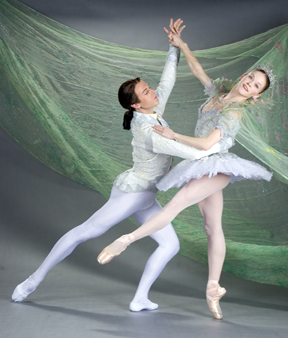"Cinderella" In Chicago
“Cinderella”
The Joffrey Ballet
Auditorium Theatre
Chicago, IL
October 4, 2006
by David Vaughan
copyright 2006 by David Vaughan
 Pickings are slim for Ashton lovers these days; even the Royal Ballet, which after the centenary celebration of 2004 might be thought to have restored his works to the ascendancy in its repertory that they deserve, is offering only a few performances of Rhapsody early next year, and of Symphonic Variations towards the end of the season. So I grabbed the opportunity to see The Joffrey Ballet in its new production of Cinderella at the superb Auditorium Theatre in Chicago. It had long been Robert Joffrey’s wish to add this to the list of Ashton ballets he had been able to secure for his company, and that wish has now been realized, eighteen years after his death, by his co-founder, Gerald Arpino.
Pickings are slim for Ashton lovers these days; even the Royal Ballet, which after the centenary celebration of 2004 might be thought to have restored his works to the ascendancy in its repertory that they deserve, is offering only a few performances of Rhapsody early next year, and of Symphonic Variations towards the end of the season. So I grabbed the opportunity to see The Joffrey Ballet in its new production of Cinderella at the superb Auditorium Theatre in Chicago. It had long been Robert Joffrey’s wish to add this to the list of Ashton ballets he had been able to secure for his company, and that wish has now been realized, eighteen years after his death, by his co-founder, Gerald Arpino.
Many companies all over the world have presented Cinderella, but only the Joffrey in the United States. The ballet was staged by Wendy Ellis Somes, Michael Somes’s widow, who now owns the rights, with “additional staging” by Christopher Carr. Robert Joffrey always had company veterans Gary Chryst and Christian Holder in mind for the Stepsisters, and they returned as guest artists in all but one of the four casts who danced in the nine performances. Like others who have played the vain and imperious Helpmann sister, Holder overdid it a bit, I thought, but Chryst, as the Ashton sister, found his own character—sweet and winsome, even rather pretty, but with occasional flashes of temper.
Maia Wilkins, as Cinderella, tended to indicate the emotions of the first act rather than really playing them from the inside, but in the second both she and Willy Shives, as the Prince, touchingly expressed their wonder at the miraculous turn of events they find themselves caught up in. Both their pas de deux, the first in the ballroom scene with its lovely dying fall, and the second at the end of the ballet, had all the tenderness that we find in an Ashton pas de deux: as always, he gives us more than a ballerina and her partner but poignantly shows us two young people falling in love. Shives is an excellent actor—like Gary Chryst, he was marvelous as the Bridegroom in the Joffrey’s production of Ashton’s A Wedding Bouquet—and curiously, he plays Cinderella’s father in another cast.
 The Joffrey lists all its dancers as “artists of the company,” though some no doubt are more equal than others, and all the leading roles were double- and even triple-cast: Maia Wilkins could be seen on another night as the Fairy Summer; Julianne Kepley, Fairy Godmother on the first night, was Cinderella later; Victoria Jaiani danced both Cinderella and the Fairy Winter. This actually means that most of these roles were cast from strength, and this is a strong company, down to the corps de ballet of Stars.
The Joffrey lists all its dancers as “artists of the company,” though some no doubt are more equal than others, and all the leading roles were double- and even triple-cast: Maia Wilkins could be seen on another night as the Fairy Summer; Julianne Kepley, Fairy Godmother on the first night, was Cinderella later; Victoria Jaiani danced both Cinderella and the Fairy Winter. This actually means that most of these roles were cast from strength, and this is a strong company, down to the corps de ballet of Stars.
Calvin Kitten’s Jester was a big audience-pleaser, and he certainly dances brilliantly. But Alexander Grant, who originally danced this part, was more than just another Soviet-style Jester out of Swan Lake: he had a relationship with the Prince, and sadly watched the lovers’ departure at the end of the ballet (he doesn’t even appear in the last scene any more). I wish someone would ask Grant to help bring back the deeper side of this character.
The Joffrey has acquired the third of the four Royal Ballet designs, those by David Walker from 1987, which have also done duty at the Dutch National Ballet and the Royal Swedish Ballet. They are certainly preferable to the most recent Royal version, but I would rather have seen the second, by Henry Bardon and David Walker, with its beautifully painted drops for the series of transformations in the divertissement of the Seasons. Those dances, and the ballabili of the Stars, and the two pas de deux and variations, form the choreographic heart of the ballet, and earn it a place in the list of Ashton’s masterpieces.
Volume 4, No. 37
October 16, 2006
copyright ©2006 David Vaughan
www.danceviewtimes.com